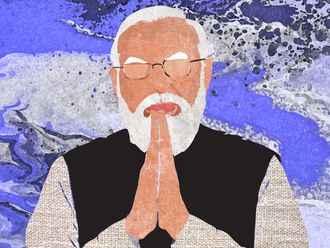The motorcyclist merged onto the I-5 at Riverside Drive. In a tight ecru leather jacket, jeans that hugged her like a second-skin and black spike-heeled boots, she was dressed to kill.
I just hoped she wasn’t going to kill me.
I was on the back of her bike, wearing dorky jeans and a look of pure terror.
Susanna Schick had offered to show me what it’s like to ride a motorcycle between cars during rush hour. The controversial practice, known as lane-splitting, is commonplace on California’s clogged freeways but unnerving to some motorists.
You’re crawling along in your car and, suddenly, a motorcycle comes whipping past, straddling traffic lanes. Sometimes it whizzes by before you know it, other times you startle and think: Is that even legal? Are they suicidal?
“Lane-splitting,” Schick said, “is safer than sitting behind a car waiting to get rear ended.”
Don’t spit out your coffee. She’s right.
According to a new study by UC Berkeley researchers who analysed nearly 6,000 California motorcycle accidents, only 997 involved lane-splitters. Epidemiologist Thomas Rice and his colleagues found that compared to other bikers who crash, lane-splitters wear better helmets, travel at lower speeds, are far less likely to have alcohol in their systems or to be carrying passengers.
More important, lane-splitters are injured far less often, and less severely.
“Lane-splitting,” Rice wrote, “appears to be a relatively safe motorcycle riding strategy if done in traffic moving at 50 miles per hour (80km/h) or less and if motorcyclists do not exceed the speed of other vehicles by more than 15mph (24km/h).”
As to whether it’s legal, the CHP tolerates it, but there’s nothing in state law that directly permits or prohibits it. That may change, however, as California lawmakers weigh a first-in-the-nation bill that would explicitly allow it. The measure, passed in the Assembly, is scheduled to be taken up at a Senate committee hearing July 14.
“I think it’s ridiculous that it’s illegal anywhere,” Schick said. “It’s just this culture of fear that dominates America. We’re being fed this message: It’s not safe. You have to stay inside, watch TV, don’t travel, don’t ride a motorcycle. I feel sorry for people who let fear rule their lives.”
There is nothing about Schick, 45, that telegraphs fear.
In motorcycle circles, her nickname is Pinky Racer. She once was pulled over by a cop in New Hampshire who clocked her speed at 172km/h. “It was the middle of nowhere,” she explained, “and I wanted to see how fast it could go.” He had followed her for 11km before she noticed him.
She bought her first scooter at fifteen-and-a-half, the moment she got her learner’s permit in San Mateo. “I asked the guy who sold it to me, ‘How do you work this thing?’ “ She promptly launched it into the bushes. Some years later, she was seriously injured when a driver turned left in front of her — a not uncommon way to die on a bike.
“It was a really bad crash,” she said. Her injuries forced her to leave design school for a semester.
Traumatised, she stopped riding and went off to study fashion in Paris. Schick worked for J. Crew, Isaac Mizrahi and Betsey Johnson in New York and later got her MBA.
To escape the city, she started riding again. She bought a vintage BMW, then a Ducati. She was ultra-safety conscious, never without a helmet, extremely careful in intersections.
Then, after a friend let her ride his Yamaha R-1 around the track at Laguna Seca in Northern California, she got a taste for racing. “I was ‘Oh, yeah. This is why power is nice.’ “
The first time she raced, another rider rear-ended her. “I broke my collarbone, but didn’t even notice till I was sitting in the ambulance on the way to the hospital to get my head checked out.”
Over time, she has suffered seven concussions and many broken bones. The worst crash of her life happened in downtown Los Angeles in 2012, when she was riding down Spring Street — on a bicycle. Schick lost control when she saw a car barrelling down the street behind her.
“I broke my pelvis in three places, five ribs and my collarbone,” she said. “I broke more bones in that bicycle crash than in all my motorcycle crashes combined.”
Schick, who works for a couple of apparel companies in Vernon, can’t imagine commuting in a car. She has one, but only for rainy days and trips to Ikea.
The moment we pulled out of the driveway of the Frogtown apartment Schick shares with her boyfriend and fellow motorcycle enthusiast Robert Verez, I had serious second thoughts. She told me to hold onto the gas tank of the Triumph Thruxton for better stability, but that felt tenuous, so I clutched her tiny waist.
The first few times she accelerated, I had the strong sensation I was about to fly off the back. Oh my God, I thought, I’m not wearing a seat belt!
Traffic was light on the southbound side of the freeway. But the other direction was jammed — and full of big, scary looking trucks. We exited, made a U-turn then plunged into the heavy traffic.
Suddenly we were threading the narrow spaces between lanes. I forced myself to keep my eyes open. I started to see a pattern. Schick wove adroitly between lanes and cars, looking for openings that always appeared. I started to relax.
And then, just ahead, an enormous white tour bus loomed in the fast lane. A huge delivery truck had pulled even with it in the next lane. The opening was too narrow for us. I knew this was a mistake.
The truck sped up a bit, and bus seemed to slow down. Schick scooted into the gap and sailed ahead.
I exhaled. As I did, a little voice in my head said, “Eat my dust!”
— Los Angeles Times











